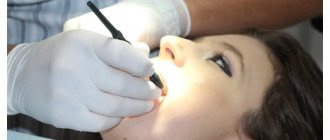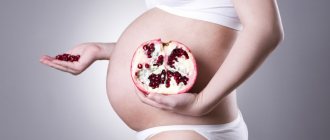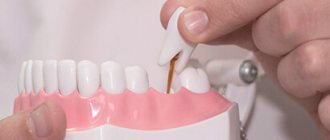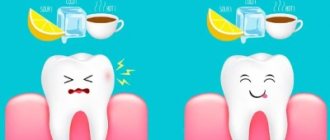27.11.2019
Pregnancy is a special period in a woman’s life, during which it is necessary to be most responsible and careful when using any medications. Especially those that can have a significant impact on the body of the expectant mother. These drugs include any painkillers used during anesthesia and anesthesia.
It is not surprising that many women are afraid to use anesthesia even for severe toothache, as they are not sufficiently aware of the safety of this procedure.
Why should a pregnant woman go to the dentist?
After the gynecologist - to the dentist! If your suspicions about pregnancy are confirmed, the first, or one of the first, doctors you visit after leaving the antenatal clinic should be a dentist - even if you have never complained about your teeth before.
The oral cavity is home to about 50 million bacteria, the main food of which is carbohydrates. They obviously don’t have to complain about the lack of food, so they multiply - in warmth and satiety - with truly incredible speed, especially if their “owner” has a sweet tooth! And if it is not the owner, but the hostess “in an interesting position,” there are even more conditions for a comfortable life and rapid reproduction of microbes.
The increased appetite that usually accompanies pregnancy encourages you to consume more carbohydrates. Frequent vomiting in the first trimester can lead to increased acidity in saliva. Acidic environment and excess carbohydrates - what else does the microflora need?!
Due to the increased need for calcium, greater than usual, tooth enamel, the shield that protects teeth from contact with the microflora of the oral cavity, is also at risk during pregnancy. In your situation, the slightest damage to tooth enamel is fraught with the rapid development of caries: after all, the fetus is actively developing its skeletal system, and with the slightest lack of calcium in the body, it begins to “wash out” from the mother’s teeth and bones.
There is another reason why it is absolutely necessary to make time during pregnancy and after childbirth to visit your dentist (and, if possible, a periodontist). As you probably already guessed, this is periodontal disease. It (and its initial stage - gingivitis) can be safely called the disease of the century.
At least half of the adult population of our country suffers from gingivitis (without always knowing it). With this disease, hypertrophy of the interdental nipples develops, the edges of the gums become inflamed, the gums begin to bleed, and sometimes tooth mobility is observed. Unfortunately, pregnancy greatly increases the likelihood of developing gingivitis - there is even such a thing as “pregnant gingivitis.” If gingivitis develops during pregnancy, a woman has a much greater chance that her oral health will return to normal after childbirth than if she already suffered from this disease by the time she became pregnant. Therefore, my advice to you is - do not neglect visits to the dentist (at least once every six months) even before conception! Treatment of gingivitis comes down to anti-inflammatory measures and systematic sanitation of the oral cavity.
It is necessary to visit your dentist regularly to remove plaque and tartar. It is not only possible to treat bad teeth during pregnancy, but it is absolutely necessary - otherwise after childbirth it may turn out that there is nothing left to treat. In addition, carious teeth are simply a haven for a variety of microorganisms, including pathogenic ones, which can cause very unpleasant diseases in both mother and child.
Features of dental treatment for pregnant women
Dental treatment is a mandatory medical procedure, regardless of whether a woman is preparing to conceive a child or is already pregnant. The dentist’s tactics depend on the trimester of pregnancy, its course, the general somatic health status of the pregnant woman and indications for treatment. Peculiarities of management of pregnant women are characterized by the following features:
Treatment planning
During pregnancy, emergency dental treatment is performed, the indications for which are:
- Carious lesions of hard and soft tissues of teeth: pulpitis, periodontal inflammation (periodontitis).
- Pathological processes of soft tissues of the oral cavity, gums: gingivitis, stomatitis, cheilitis, glossitis, inflammation of periodontal tissues.
- Tooth injuries: fracture of the crown or root of the tooth, dislocation, cracks and chips of the crown part.
- Abscesses.
- Acute purulent inflammation of the jaw bone tissue.
Planned therapy (orthodontic, implantological and orthopedic treatment) is postponed to the postpartum period.
Pregnancy data
Before starting treatment, you should inform your doctor about the duration and course of pregnancy, taking medications prescribed before conception and during pregnancy, and bad habits. These data can significantly affect the treatment plan drawn up by the dentist.
X-ray diagnostics
X-ray examination is extremely undesirable in all trimesters of pregnancy: failures in the formation of fetal cells can lead to irreparable consequences and abnormalities. The 1st and 3rd trimesters are especially dangerous for radiation diagnostics, however, the 2nd trimester is no exception, although it includes lower risks of developing pathology.
Dental filling
When filling teeth, materials of both chemical and light curing are used. Curing lamps used for curing are also not safe for the developing fetus.
Anesthesia
At the present stage of development of dentistry, painkillers are produced that are absolutely harmless to the pregnant woman and the fetus. High-quality anesthesia is half the success of treatment.
We know that it is possible to treat in a certain trimester
Pain relief at the dentist during pregnancy
Local anesthesia (an injection into the gum) is quite possible, however, during pregnancy there are a number of restrictions and features, so you must inform your doctor that you are expecting a baby.
Even if you still suspect that you might be pregnant, it is better to play it safe and tell your dentist about your suspicions - he will certainly select an effective and safe anesthetic for you and the child (for example, ultracaine or ubistezin). There are people who are terrified of the dental office and dream of solving their “dental” problems “by magic” - with the help of general anesthesia. I would like you to know: dental treatment under general anesthesia is generally a double-edged sword (no one can predict in advance how your body will react to anesthesia), and during pregnancy it is completely contraindicated.
Dental treatment in the I, II and III trimesters
The dentist’s tactics when treating teeth in pregnant women depend on the specific stage of pregnancy - trimester.
Treatment in the first trimester
The first trimester is the time from the 1st to the 13th weeks of pregnancy. This period is characterized by the formation of the rudiments of the organs of the unborn child. At the same time, the placenta does not yet provide adequate protection of the fetus from the influence of factors of the external and internal environment of the mother’s body.
In the first trimester, a pregnant woman is worried about toxicosis, manifested by systematic nausea, short-term vomiting, hypersalivation, slight dizziness, and slight hyperhidrosis. Any, even minor, stress factor can cause a violent reaction in the body, even leading to miscarriage.
In dental treatment, courses of remineralization therapy and professional teeth cleaning without the use of ultrasound are acceptable. Filling, tooth extraction, prosthetics, dental implantation and x-ray diagnostics are contraindicated during this period.
Treatment in the second trimester
The second trimester lasts from the 14th to the 26th week. The placenta in this trimester is fully formed and provides reliable protection for the fetus. Dental treatment carries fewer risks, but still requires consultation with a gynecologist. During this period, you can perform dental fillings, surgical treatment (strictly according to indications), therapy for inflammatory diseases that may worsen by the 3rd trimester or after childbirth, professional removal of dental plaque (hard and soft).
Treatment in the third trimester
The third trimester is the period from the 27th week until birth. During this period, the woman’s body is actively preparing for childbirth, and therefore may be somewhat weakened. A pregnant woman experiences tachycardia, increased breathing, shortness of breath, decreased blood pressure, and increased anxiety. The woman constantly feels tired. Treatment in the 3rd trimester is exclusively emergency. Planned procedures are postponed until the postpartum period.
In all three trimesters, pregnant women are allowed to carry out professional oral hygiene, the method of which will vary depending on the timing of pregnancy and the condition of the body of the expectant mother.
Fluoridation of pregnant teeth
To preserve and strengthen tooth enamel, doctors often recommend so-called local fluoridation with fluoride-containing solutions and varnishes. The fact is that fluorides suppress the metabolism of bacteria, promote hardening of the surface of the teeth and increase the resistance of teeth to acidic environments. In domestic dentistry, two methods of fluoridation are practiced. With the application method, a so-called “individual tray” is made - a kind of individual wax impressions of the teeth. A fluoride-containing composition is poured into the recesses of such impressions, and then they are applied to the patient’s teeth. This procedure requires 10-15 visits to the dental office. The second method is to apply fluoride-containing varnish with a brush to the surface of the teeth (in 3-4 visits).
Teeth whitening during pregnancy
The teeth whitening procedure consists of two stages. First, plaque and tartar are removed and removed, then the teeth are treated with special whitening pastes and elixirs. Plaque is removed either using ultrasound (it may make sense to refrain from this procedure in the first half of pregnancy), or using special pastes that are used to treat each tooth separately (which is absolutely safe at any stage of pregnancy). Whitening pastes and elixirs are completely harmless to the mother or fetus. The teeth whitening procedure usually lasts about an hour.
What kind of water should a pregnant woman drink?
It has been proven that fluoridation of drinking water significantly reduces the likelihood of developing caries. In our country, fluoridation is carried out (the standard concentration of fluoride in drinking water is 1.5 mg/l), however, unfortunately, there are frequent cases of both a lack and an excess of fluoride in drinking water. Don't think that low fluoride levels are the only cause for concern. An excess of this element is fraught with fluorosis (a specific lesion of tooth enamel, manifested externally in the form of yellow spots), which threatens not only the mother, but also the unborn baby (after all, baby teeth are formed at 3-5 weeks of intrauterine development). You can find out what the concentration of fluoride is in your drinking water at your local SES (but do not expect that SES employees will, on their own initiative, inform you about the level of fluoridation in your drinking water!). To regulate the level of fluoride in water, you can use special filters that are now commercially available.
Dental hygiene during pregnancy
And yet, the main way to fight bacteria is regular (at least 2 times a day!) brushing your teeth and sanitizing the oral cavity. When brushing your teeth, you must follow a number of simple but very important rules:
- The toothbrush should have stiff bristles of different lengths, the head should be elastic and movable (different bristle lengths and the elasticity of the head will ensure better “passability” of the brush). The brush should be changed 2-3 times a month. Fluoridated paste is preferable (see above).
- It is necessary to brush all surfaces of the teeth - the front, palatal ("backside") and chewing ("horizontal"), brush movements - vertical and following the contours of the gums. You need to brush your teeth in the morning and evening (at least) for 3-5 minutes.
- The most vulnerable area to the harmful activity of bacteria is the border between the gums and teeth. These areas need to be cleaned especially carefully and at the same time with great care so as not to injure the gums.
- It is useful to know that caries most often begins with the last - seventh or eighth - teeth. These teeth should be given special attention when brushing.
- No matter how masterfully you use a toothbrush, at least a third of the surface of your teeth will still remain inaccessible to you. Therefore, it is recommended to use floss every day after meals - a special silk thread for cleaning interdental spaces (even fluoridated flosses have appeared recently). In the absence of floss, you can also use a toothpick, but with its help it is more difficult to “get” to hard-to-reach places, in addition, the toothpick should be used carefully so as not to injure the gums.
- As an additional remedy, you can use dental elixirs that have both a cleansing and protective effect. There are special devices that supply dental elixir under pressure, which allows you to “get” to the most inaccessible places.
If you brush your teeth after every meal, it is easier to deal with harmful bacteria, but this, as you understand, is not always available to everyone. Try to at least rinse your mouth after eating, and if you enjoy something sweet, it is useful to eat a piece of cheese. The fact is that there is such a thing as the buffer capacity of saliva. Without going into details, let's say that this indicator characterizes the ability of saliva to neutralize acids and bases. It has been proven that when eating carbohydrate foods, the buffer capacity of saliva decreases, while protein foods (including cheese) increase it, and therefore resistance to caries.
Procedure for tooth extraction:
- anesthesia;
- detachment of the gums from the dental crown;
- grasping the crown with special forceps;
- gentle movements back and forth to loosen;
- removal of the lower or upper tooth;
- treatment of the wound, suturing if necessary.
After the operation, it is necessary to monitor the patient’s condition for at least half an hour - periodically check blood pressure and pulse rate. Then give the necessary recommendations and release. It is advisable that she does not drive on this day, and that she has someone accompanying her.
If the tooth is open, removal may be avoided. Prescribe rinsing with solutions to liquefy and remove pus. If the channels are more or less passable, this can help relieve pain for a while. The pain occurs due to the pressure formed by the pus due to inflammation on the surrounding tissue. Once the outflow is created, the pain will subside almost immediately.
But, as mentioned above, only a doctor, after carefully weighing all factors, decides to remove or postpone. Therefore, in any case, you need to contact a specialist. If you take any independent actions, they can worsen the situation even further. It is better not to take risks due to fear of visiting the dentist.
Diet
First, as already mentioned, you should limit your intake of foods rich in carbohydrates, and first of all, your intake of sugar. It is necessary that food contains in sufficient quantities all the macro- and microelements and vitamins necessary for the human body. Calcium, phosphorus and fluorine1, as well as vitamin D are especially important (cod liver oil, cod liver and Atlantic herring, chicken eggs and some other foods are rich in vitamin D).
Dear expectant mothers, this may sound like a pun, but remember: your teeth are in your hands!
1 About the role of calcium in the body, food and other sources of calcium, see this issue of the journal: L. Belinskaya “Macroelements”. A continuation of this article will be published in the next issue, where you will find information about microelements, incl. phosphorus and fluorine.
Effect of anesthesia
Sitting at the dentist's office, people are afraid of the discomfort and pain that always accompany dental treatment. But a solution has long been found - pain relief. How do pregnant women tolerate anesthesia? Are they allowed to take painkillers? Many dentists answer that such an injection is simply necessary. After all, expectant mothers will experience unnecessary anxiety and fear of feeling pain while waiting for their turn to see a doctor. And stress negatively affects the well-being and development of the baby in the womb, so she does not need worry at all and is even contraindicated.
Is it safe to give a painkiller injection to pregnant women? If we are talking about general anesthesia, then its influence can still negatively affect both the child and the expectant mother. But local anesthesia can be done using modern medications. They will perfectly anesthetize a small area of the gum, since they act in a targeted manner, and will limit the pregnant woman from terrible torment in the dental chair during the treatment process. In addition, the dose of the drug is very small, so you should not be afraid that the drug gets to the baby along with the blood; its components will still not pass through the placenta.










